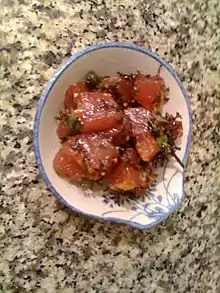Limu (algae)
Limu, otherwise known as rimu or ʻimu (from Proto-Austronesian *limut)[1] is a general Polynesian term for edible plants living underwater, such as seaweed, or plants living near water, like algae.[2][3] In Hawaii, there are approximately one hundred names for kinds of limu, sixty of which can be matched with scientific names.[4] Hundreds of species of marine algae were once found in Hawaii.[5] Many limu are edible, and used in the cuisine throughout most of Polynesia.

Uses
Several species of limu are used as food throughout Polynesia and is typically eaten raw as accompaniment to meals, usually fish.
In Hawaii, limu was seen as a major component of the Hawaiian diet alongside fish and poi.[6] Hawaiians cultivated several varieties of seaweed for food as well as to feed fish farmed within fish ponds. As many as 75 types of limu were used for food, more than the 35 used in Japanese cuisine, which is also well known for its use of seaweed.[5] In modern times, limu is often used as a condiment, typically in raw fish dishes such as poke.[7]
Limu was used in hoʻoponopono, the ancient Hawaiian process of conflict resolution. Injured and accused parties gathered to pray, seek forgiveness and eat limu kala leaves as a symbol of reconciliation.[7][8] It is also used in traditional hula attire[9] and as medicine.[10]
Due to the shape of its foliage, the Maori also applied the name rimu to the native tree Dacrydium cupressinum.[2]
Types
Limu comes from multiple genera[6]
Cook Islands
- Rimu akau (Sargassum sp.)
- Rimu kai (Caulerpa racemosa)
- Rimu oma (Hydroclathrus sp.)
- Rimu taratara (Turbinaria sp.)
Easter Island
- Auke (Dictyopteris australis)
- Miritoni (Sargassum obtusifolium)
French Polynesia
- Konini (Caulerpa racemosa) (Rapa Iti)
- 'onini (Caulerpa racemosa) (Tahiti)
- Rimu miti (Ulva lactuca) (Tahiti)
Hawaii
- Limu ʻeleʻele (Ulva prolifera)
- Limu kala (Sargassum aquifolium) – employed during hoʻoponopono.
- Limu koele – "dry or hard"[5]
- Limu a kohu (Asparagopsis taxiformis) – most popular
- Limu huluhulu waena (Grateloupia filicina or "pubic hair") – favorite of Liliʻuokalani.[8]
- Limu hina (Hypnea sp.)
- Limu lipoa (Dictyopteris plagiogramma) – once found in almost continuous beds around O‘ahu. Disappeared from Waikiki Beach in the 1960s, crowded out by pollution and the invasive Gracilaria salicornia.
- Limu loloa (Gymnogongrus long or slender) [5]
- Limu manauea (Gracilaria coronopifolia, ogo [Japanese]) – cooked with meats to form a savory jelly. Later diced raw with poke, mixed with chili and salt.[8]
- Limu palahalaha (Ulva lactuca) – used in hula[11]
- Limu wawaeʻiole (genus Codium, species Codium edule)
- Pakaiea (Ulva lactuca and Monostroma oxyspermum) – named after a shark god who was swaddled in its silken leaves.[8][12]
- Lepelepe-o-Hina – shawl of the goddess Hina. Shares its name with a native butterfly and a family of nudibranchs.[8]
New Zealand
- Kapoke whero (Gracilaria chilensis)
- Karengo (Pyropia sp.)
- Karepō (Zostera sp.)
- Koiri (Caulerpa racemosa/Caulerpa sedoides)
- Kōauau (Xiphophora gladiata)[13]
- Rehia/Rimurehia (Gigartina sp.)
- Rimurapa (Durvillaea antarctica)
- Rimurimu (Caulerpa brownii)
Niue
- Limu fua (Caulerpa racemosa)
- Limu tahi (Caulerpa cupressoides)
Samoa
- A ʻau (Halymenia sp.)
- Fuofua (Caulerpa racemosa)
- Limu aau (Gracilaria sp.)
- Limu lautalatala (Turbinaria sp.)
- Limu vaova (Sargassum sp.)
Tonga
- Fuofua (Caulerpa peltata)
- Kaka (Caulerpa serrulata/Caulerpa cupressoides)
- Limu vai (Hypnea charoides)
- Louniu (Caulerpa sertularoides)
- Palalafa (Caulerpa scalpeliformis)
- Tangau (Cladosiphon sp.)
- Toke (Caulerpa racemosa)
Threats
Limu has become increasingly difficult to find because of over-picking, pollution, and urban development,[14] especially construction in watersheds. Many important kinds of limu grow best in brackish water where fresh water empties into the sea. Another threat to limu is the spread of marine alien invasive species, such as members of the genus Kappaphycus (smothering seaweed), Gracilaria salicornia (gorilla ogo), Avrainvillea amadelpha (leather mudweed), Hypnea musciformis (hook weed) and Acanthophora spicifera (prickly seaweed).[15]
See also
Further reading
- Abbott, Isabella Aiona (1992). Lā'au Hawai'i: Traditional Hawaiian Uses of Plants. Bishop Museum Press. ISBN 9780930897628.
- Abbott, Isabella Aiona; Huisman, John Marinus (2004). Marine Green and Brown Algae of the Hawaiian Islands. Bishop Museum Press. ISBN 9781581780307.
References
- Blust, Robert; Trussel, Stephen (2010). "*limut: moss, algae". Austronesian Comparative Dictionary. Max Planck Institute for Evolutionary Anthropology. Retrieved 7 December 2022.
- "Limu: Seaweed, mosses and algae of polynesia". Te Māra Reo: The Language Garden. Benton Family Trust. 2022.
- "Nā Puke Wehewehe ʻŌlelo Hawaiʻi". wehewehe.org. Retrieved 2019-04-26.
- Aiona Abbott, Isabella. "Limu" (PDF). Retrieved 2008-09-05.
- MacCaughey, Vaughan (1916). "The Seaweeds of Hawaii". American Journal of Botany. 3 (8): 474–479. doi:10.1002/j.1537-2197.1916.tb05429.x. ISSN 0002-9122. JSTOR 2435240.
- "Edible Limu of Hawaii". www.hawaii.edu. Retrieved 2019-04-22.
- Spalding, Heather. "Got limu? Uses for algae in Hawaii and beyond" (PDF). University of Hawaii. Retrieved April 25, 2019.
- Wianecki, Shannon (2010-03-01). "The Lure of Limu". mauimagazine.net. Retrieved 2019-04-22.
- "New Algae Species Discovered in Hawaii's Deep Waters". www.papahanaumokuakea.gov. Retrieved 2019-04-26.
- Reed, Minnie (1907). Economic seaweeds of Hawaii and their food value. Washington, U.S. Government Printing Office. hdl:10125/42229.
- "Limu Palahalaha". Waikīkī Aquarium. 2013-11-11. Retrieved 2019-04-26.
- Lincoln, Noa Kekuewa (2020-10-31). Kō: An Ethnobotanical Guide to Hawaiian Sugarcane Cultivars. University of Hawaii Press. ISBN 978-0-8248-8307-2.
- New Zealand Marine Studies Centre (2015). "Māori Southern NZ Rocky Shore Guide" University of Otago Retrieved May 2023.
- Hiraishi, Ku`uwehi (12 April 2018). "Cultivating a Future for Hawaiian Seaweed". www.hawaiipublicradio.org. Retrieved 2019-04-26.
- "Invasive Algae". Aquatic Invasive Species. 2013-12-09. Retrieved 2019-04-22.
External links
- "The Limu Hui". KUA. 2016-02-02. Retrieved 2019-04-22.
- "Reef Watcher's Field Guide to Alien and Native Marine Algae". www.hawaii.edu. Retrieved 2019-04-22.